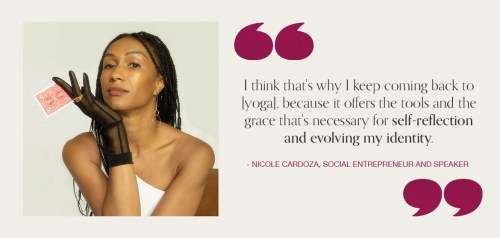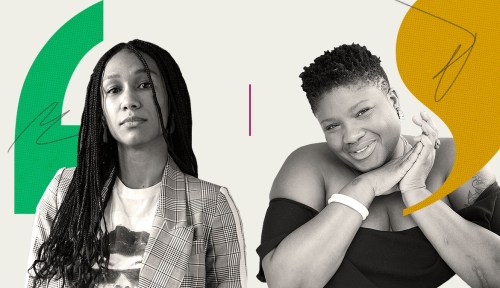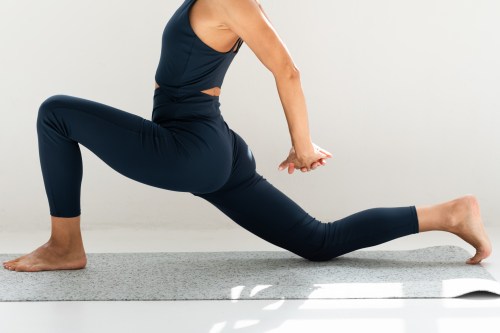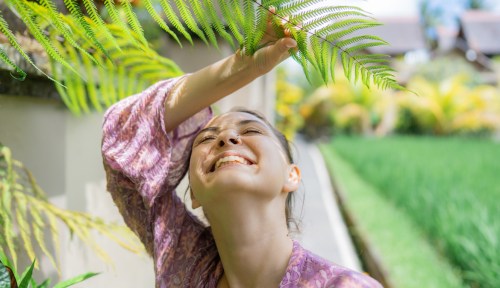Our editors independently select these products. Making a purchase through our links may earn Well+Good a commission
In Sanskrit, the word “yoga” translates “to yoke” or “to unite,” but in the United States, the yoga industry historically has not and still isn’t living up to the inclusive definition of its name. A 2013 study found that about 85 percent of those practicing yoga in the US are white, and while no statistics exist about the number of queer practitioners, career site Zippia estimates that only about 10 percent of all yoga instructors identify as LGBTQ+. In other words: The odds are low of walking into a yoga studio as a queer, Black, Indigenous, person of color (BIPOC) and feeling a united sense with kindred people.
Experts in This Article
yoga teacher, body positivity advocate, and writer based in Durham, North Carolina
award-winning serial social entrepreneur, investor, author, and public speaker
Ahead, two leaders in the yoga community, who are also each part of the queer and BIPOC communities, share how they believe yoga could grow into a practice that accepts and accommodates all folks. Meet Jessamyn Stanley, yoga teacher, body-positivity advocate, and authorof Yoke: My Yoga of Self Acceptance; and Nicole Cardoza, award-winning social entrepreneur, public speaker, and author of Mindful Moves: Kid-Friendly Yoga and Peaceful Activities for a Happy, Healthy You. In this conversation, Stanley and Cardoza discuss how the yoga industry has historically excluded people in marginalized communities, how it could evolve toward inclusion, and why a home practice can provide space to fully embody and accept yourself for who you are.
Kells McPhillips: To start, I would love for you both to share how you found your way to yoga in the first place and how your practice has evolved amid the pandemic.
Nicole Cardoza: I stumbled into yoga when I was in college. For many years of my life, it really provided a refuge where I could find myself and manage some mental-health struggles that I was going through at the time. As my practice has evolved throughout my professional career, I think I found a level of patience with it that I haven’t had previously.
I think that patience came from being able to practice in isolation over the past couple of years during the pandemic, which also consciously removed me from the yoga industry. I’m in a very reflective and intimate space with my practice, which I haven’t been in previously.
Jessamyn Stanley: I started practicing yoga when I was in graduate school, also when I was experiencing mental-health struggles. I was in a nonprofit arts management graduate program, and I was like, “Is this even what I want to do with my life? Do I even know anything about myself?” I was also going through a breakup at the time, which tends to facilitate some sort of life change.
A really good friend of mine was like, “You should come to a yoga class with me!” and I really thought that yoga was just for thin white women. I didn’t know that it had anything to do with me or anybody who looked like me, but I ended up going to class. And what I most appreciated about it was that every part of it seemed impossible to me. It seemed like everybody had gotten together and practiced together beforehand to come to class to do it all in tandem.
What I appreciated was this opportunity to just see my boundaries, see my barriers, and see what I’ve decided that I’m allowed to do. And then I could say, “I’m just going to try—even if I fall down, even if everyone in this room sees that I don’t know what I’m doing, even if I’m going to be embarrassing myself in the biggest way. I’m still just going to try.” At the time, I didn’t realize how revolutionary that would be to just try. I didn’t realize the many parts of my life in which I was not trying.
Yoga pushed the boundaries of what I thought I could do. And that is why I continue to return to my practice to this day: It’s just because it always gives me that exact same medicine. Ultimately, yoga is about how we connect with each other by how we connect with ourselves.
The pandemic made it so that you had to stay at home and be by yourself, period. Then on top of that, you had to manage yourself through the worst thing that has happened in living collective history.

KM: Do you consider your yoga practice in conversation with queerness? If so, how?
JS: I definitely think that they’re linked, but I don’t consciously think about it all the time. Yoga, ultimately, is about acceptance, and the literal translation of the word “yoga” is often closely translated as “union.” Union as in bringing together the pieces of yourself that don’t always make sense and don’t always seem to go together, but that do go together. That union is the process of acceptance.
To accept yourself means to accept the parts of yourself that puritanical culture would hope to breed out. We live in a very puritanical society where divine sexuality and sensuality and eroticism are cast down as being dangerous and bad and scary and problematic. So if you’re in a process of self-acceptance through yoga, then acceptance of that which has been deemed dangerous and bad is inevitable.
From that place, you see that what is really feared in sexuality and sensuality and eroticism is creation. What’s being feared is generation: that which will lead to something else. All that eroticism really holds is our ability to manifest new life. And if you are resting in that place of self-acceptance, then you’re resting in a place of generation and creation.
NC: That’s really powerful. It’s not something I think about often because I think that my relationship to queerness is just as much of a practice as yoga itself. My practice simply extends the space and expands the possibilities of who I am and how I can show up. If you can accept yourself proverbially on your mat, you create that space for yourself. You have an awareness of how you want to be received in the spaces that you wish to occupy as a person off the mat.
My practice has helped me understand how to eliminate some of the chatter that comes from broader society about what spaces I should take up and which I should occupy. It’s a practice. My identity is certainly not set in stone. It develops and becomes more nuanced, beautiful, and whole as I continue to explore it. I think that’s why I keep coming back to it, because it offers the tools and the grace that are necessary for self-reflection and evolving my identity.
KM: You both have spoken so much about your home practices. Why does this setting help you feel free on your mat?
JS: Studio classes are great—but having your practice fully rooted in a studio means that it’s dependent on that studio. The pandemic was a test of what happens when you can’t go out to the studio. But if you have your home practice, you always have a safe place to come back to. It’s reminding you that the real home that you’re seeking is not a physical place. It’s living within you. It’s also really normal in a studio class to be totally distracted by the people on the mat next to you, trying to do a good job for them and not thinking about practicing for yourself or just experiencing it for yourself.
Now, I don’t mean that you shouldn’t have teachers. If you have access to an Internet connection, you don’t have to subscribe to a specific platform. You can literally go on YouTube, and there are thousands of videos taught by all different kinds of instructors. Each teacher is not going to resonate for everybody—but if you find a teacher who resonates for you, that is what you need to be able to guide your practice.
The teacher who has had the biggest impact on my personal practice is Kathryn Budig, and she’s taught on a variety of platforms—notably on Glo and now on her own platform, the Haus of Phoenix. Kathryn led me to the teacher that lives inside of me. The best teachers hold your hand, and then, eventually, you can let go.
NC: I also just love that home practices have platformed so many teachers who might not have been given a chance historically to reach the community that they want to work with through the traditional studios model. That’s really beautiful because there are a lot of people who started practicing yoga over the past couple of years. And they started because they saw those people, because they were able to take an Instagram Live class, or because that person started their own platform. They may not have ever seen them in the studio when they were walking down the street. So it’s really interesting for representation, and I love that it took some of the power that these brands often used to exclude people away.

KM: As the two of you have articulated, there’s solace and self-acceptance that can be found in a home practice, but how can we work toward a yoga industry that is more diverse, equitable, and inclusive of the LGBTQ+ community and otherwise in the future? What are your hopes for yoga in the US?
JS: My hope is that yoga will be used as I believe it is meant to be used: as a way for us to be present in this world and hear each other through the difficult times that lie ahead. I think that’s why yoga has always existed. I hope to see everyone who has ever wanted to teach at all having some sort of practice on whatever platform they would like, however they would like to do it.
Yoga has survived for thousands of years, and there are going to be ups and downs. When things are popular, there’s going to be discrimination—and there is so much rampant discrimination in the yoga world now. It’s currently trendy to talk about that, but less trendy to do something about it. So we need our practices to do the internal work, yes, but we also need to use the practices to actually assess the ways in which we are homophobic, transphobic, racist, ageist, ableist—the list goes on. We need to actually assess this on a personal level and then see how the personal impacts the collective. I think, that way, yoga could be used to heal our world in a larger sense.
NC: My first gut reaction was like, “I don’t care about the future of yoga.” I have lost a lot of faith in what the yoga industry has become. We have a lot of conversations where we say that we need to decolonize the yoga industry, and make it more inclusive. I’m just, quite frankly, really tired of that conversation. Oftentimes, I think we talk about the industry as something that can be solved instead of something that is inherently broken. I care deeply about this practice, but I don’t think that the yoga industry can itself be solved by representation and inclusivity because it’s swimming in the world of white supremacy that we live in.
My real hope for yoga is that, instead of us trying to use it as a tool to solve some of these inequities that we’re seeing, we ask how can we break this model? How can we use the yoga practice itself as a model for how we want to live? What would it look like if instead of trying to dismantle these systems, we instead tried to actually reimagine them?
Interview has been edited for length and clarity.
Want more Love Out Loud? Here’s a conversation between sex educators Gabrielle Kassel and Clark Hamel about how their respective pelvic-floor dysfunction uniquely impacts their sexual and gender identities. And another between Ladies Get Paid co-founders Claire Wasserman and Ashley Louise about why they each love being married to another woman.
Sign Up for Our Daily Newsletter
Get all the latest in wellness, trends, food, fitness, beauty, and more delivered right to your inbox.
Got it, you've been added to our email list.











